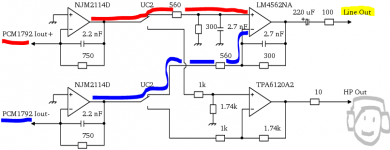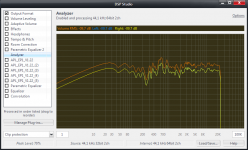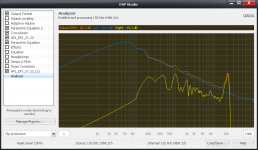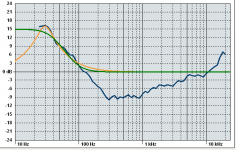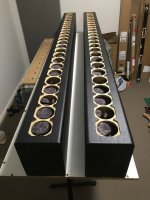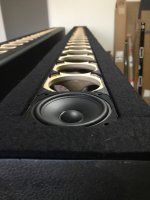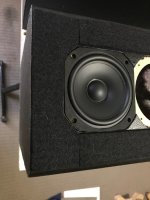.....Given the level of low frequency EQ I am considering if an analogue circuit might be useful for the low boost (at least to get it in the ballpark). I have found before that anything over 15dB is pushing the limits where the gain reduction needed can have a negative effect on the sound from the DAC.
Analog hack somewhere with a known minimum phase filter sounds as good idea, own measurements in speaker domain always showed everything is same no matter peak level served for 24bit DACs, but tend to agree with your findings that ears sometimes think else resulting in a bit negative effect to sound.
BYRTT, did you hear such a thing in my setup? These things are always dangerous territory. I have a 24 bit DAC, the Musical Fidelity M1 DAC. The most important thing with boost this high is to be very careful with the gain structure.
With a 24 bit DAC there should be enough room, we do have to check what level the amp can handle on the input side etc.
For an analogue circuit, did you catch the one by Bob/Xrk on the IDS thread?
http://www.diyaudio.com/forums/full-range/203356-cloning-ids-25s-27.html#post4849502
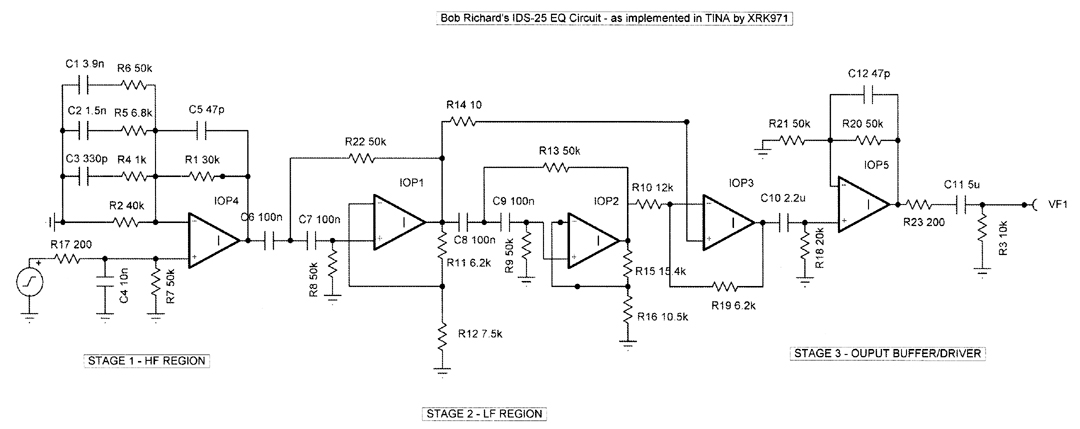
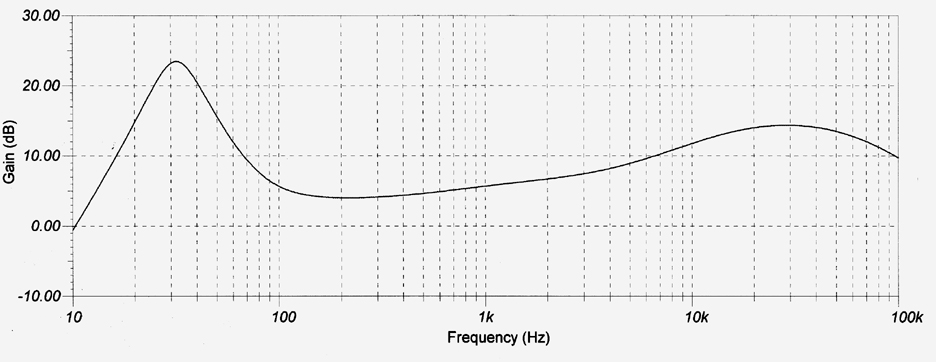
With a 24 bit DAC there should be enough room, we do have to check what level the amp can handle on the input side etc.
For an analogue circuit, did you catch the one by Bob/Xrk on the IDS thread?
http://www.diyaudio.com/forums/full-range/203356-cloning-ids-25s-27.html#post4849502


wesayso,
Your setup really sounded perfect and looked managed into details 🙂 also noticed you had JRiver policy set up to lock volume level to be slided no higher than was it in 70-80% area, you also have galvanic isolated from computer very fine M1 DAC for feeding main arrays using only Essence ST build in DACs for virtual Haas Kicker and upcoming subs. Myself run mainspeakers from Essence DACs with no computer isolation and actual there is no real buffer to isolate impedances into either your Essence ST or my Essence II they actual both run exactly same schematic as seen below using differential OPA as output buffer (Bob would immediately mod such circuit as he did to DEQ2496 😀) no use of hocus pocus from ASUS team because its just exactly same as TI suggest into PCM1792 datasheet. At moment my own lets call it jukebox system run better than ever and you know that from PM so i could get it out to some fellow that understand our hobby but has been to limits many times where i agree with what fluid said and had sometimes had analog EQ device or mixer to feed woofer amp but the gear i have is old with high impedances that then sounds as elastics compared to newer low impedance gear. JRiver visuals for my present levels are below, one is the player computer with 44kHz pink noice at full volume sending analog signal to other 192kHz locked JRiver computer feeding two way speaker with linear phase XO LR8 at 180Hz.
Your setup really sounded perfect and looked managed into details 🙂 also noticed you had JRiver policy set up to lock volume level to be slided no higher than was it in 70-80% area, you also have galvanic isolated from computer very fine M1 DAC for feeding main arrays using only Essence ST build in DACs for virtual Haas Kicker and upcoming subs. Myself run mainspeakers from Essence DACs with no computer isolation and actual there is no real buffer to isolate impedances into either your Essence ST or my Essence II they actual both run exactly same schematic as seen below using differential OPA as output buffer (Bob would immediately mod such circuit as he did to DEQ2496 😀) no use of hocus pocus from ASUS team because its just exactly same as TI suggest into PCM1792 datasheet. At moment my own lets call it jukebox system run better than ever and you know that from PM so i could get it out to some fellow that understand our hobby but has been to limits many times where i agree with what fluid said and had sometimes had analog EQ device or mixer to feed woofer amp but the gear i have is old with high impedances that then sounds as elastics compared to newer low impedance gear. JRiver visuals for my present levels are below, one is the player computer with 44kHz pink noice at full volume sending analog signal to other 192kHz locked JRiver computer feeding two way speaker with linear phase XO LR8 at 180Hz.
Attachments
A simple passive bass boost could involve an inducter parallel connected with a resistor to provide a "bass boost" effect. The inductor drops resistance boosting output below Fs of the speaker for a sealed enclosure. Played at low to moderate levels, you're not running the risk of overexcursion of the drivers. And the 1st order dB rolloff of the filter between the active regions of the resistor and the inductor would complement the 6dB rolloff of the sealed driver. Component values would be selected with resistor based upon the desired level of attenuation of the midtones and treble, nd an inductor selected such that it's impedance matches the value of the resistor at the fs of the target system. Bass boost would ramp 6dB per octave below the Fs frequency until such point that the impedance of the inductor/resistor becomes negligible to the impedance of the driver. Bear in mind that the greater the "bass boost" effect, the more attenuated the mid/high region of the driver or driver network and the less SPL as the efficiency drops.I tend to prefer a down tilting curve myself on the dipoles so I think that will be OK for now. No doubt there will be lots of tweaking and adjusting to come but I think that this will be enough to avoid total disappointment the first time I turn them on!
I am amazed how close your curve is to Roger Russell's analogue EQ in the general trend, maybe I shouldn't be as there seems to be a lot of similarity between 25 driver arrays of Vifa drivers.
Given the level of low frequency EQ I am considering if an analogue circuit might be useful for the low boost (at least to get it in the ballpark). I have found before that anything over 15dB is pushing the limits where the gain reduction needed can have a negative effect on the sound from the DAC.
Said passive bass boost also boosts output at Rf of the driver since this is close to the rolloff point of a sealed enclosure, so that the maximal impedance at Rf will create a spike in output when driven by a current source such as provided by the series resistance. Thus a notch filter may need to be added in parallel to the driver to attenuate the boost effects at Rf. Of course, for single driver full range applications, you could just build a tuned ported enclosure rather than sealed, to get the same benefit of a passive bass boost without a loss of SPL.
Something to think about. If you're using active EQ you won't need to incorporate the passive notch filter, but an RL type "bass boost" crossover may help extend the low end output at the slight expense of sensitivity. If you can boost the bass by 6dB or so using a passive 1st order boost circuit, then that is less boosting you'll need to apply to the sub-100Hz bass region. so instead of say boosting the 20-40Hz region by 15dB, you would only need 9dB of boost instead. This will give you more dynamic range in the mids where it counts since the logic level must be lowered such that the maximum EQ boost is below the clipping threshold. So if ie you were using a 16-bit DAC, you would lose considerable dynamic range at the lower output level areas such as the midbass-midtone region. with such steep curves. The passive bass boost helps negate this effect.
That was a mouthful...🙄
Last edited:
I was thinking of an opamp based active filter that could sit in the power amp as the smps has extra voltage rails for a circuit like this that could be used. There is a definite point where too much gain reduction on the input to accommodate the boost has a negative effect on the sound, it will be different for every setup though so it is hard to know without testing the difference.Analog hack somewhere with a known minimum phase filter sounds as good idea, own measurements in speaker domain always showed everything is same no matter peak level served for 24bit DACs, but tend to agree with your findings that ears sometimes think else resulting in a bit negative effect to sound.
If by dangerous you mean subjective then I would agree in part because loss of resolution in a converter is a real issue particularly with digital volume control, but it is very likely that some people will hear the effect differently and therefore argue it's validity like so many other topics 😉BYRTT, did you hear such a thing in my setup? These things are always dangerous territory. I have a 24 bit DAC, the Musical Fidelity M1 DAC. The most important thing with boost this high is to be very careful with the gain structure.
With a 24 bit DAC there should be enough room, we do have to check what level the amp can handle on the input side etc.
Changing the boost from digital to analogue shouldn't change the overall level going to the amp if the same target has been used, the point is to change the level in the converter to be more even throughout the frequency range.
Here is an example: Let's say you have a truly excellent 24bit DAC with a Signal to noise ratio of 127dB. At full volume the converter can realise just over 21 bits of resolution. The EQ average posted has a difference between the top boost and lowest cut of about 24dB that is 4 bits, so some parts of the spectrum can only be represented by 17 bits. That's OK because most music is 16 bit so you can get it all without any loss of resolution. But then you use digital volume control and for every 6dB you turn it down you lose another bit, say you listen at -18dB now you only have 14 bits on part of the spectrum. Listen at -30dB and now you are at 11 bits.
If you have a 24bit DAC with a SNR of 100dB (not uncommon) you only started with the ability to represent 16.6 bits before the noise floor.
The question remains can you hear a difference? Without being able to do an A/B test of the analogue boost it is hard to speculate.
I think it is worth trying to see if there is a benefit.
Yes I did, I was thinking to only try the low boost. I am tossing up the idea of two types of circuit. A biquad peak filter will give the majority of the boost needed but not boost below which is useful. A shelving low pass can also do most of it and the circuits are simpler to build. The downside is the unwanted boost to DC, easy enough to remove with DSP though.For an analogue circuit, did you catch the one by Bob/Xrk on the IDS thread?
Indeed 😀 Passive components only will just trade one potential issue for an actual one 🙂That was a mouthful...🙄
Attachments
I was thinking of an opamp based active filter that could sit in the power amp as the smps has extra voltage rails for a circuit like this that could be used. There is a definite point where too much gain reduction on the input to accommodate the boost has a negative effect on the sound, it will be different for every setup though so it is hard to know without testing the difference.
If by dangerous you mean subjective then I would agree in part because loss of resolution in a converter is a real issue particularly with digital volume control, but it is very likely that some people will hear the effect differently and therefore argue it's validity like so many other topics 😉
Changing the boost from digital to analogue shouldn't change the overall level going to the amp if the same target has been used, the point is to change the level in the converter to be more even throughout the frequency range.
Here is an example: Let's say you have a truly excellent 24bit DAC with a Signal to noise ratio of 127dB. At full volume the converter can realise just over 21 bits of resolution. The EQ average posted has a difference between the top boost and lowest cut of about 24dB that is 4 bits, so some parts of the spectrum can only be represented by 17 bits. That's OK because most music is 16 bit so you can get it all without any loss of resolution. But then you use digital volume control and for every 6dB you turn it down you lose another bit, say you listen at -18dB now you only have 14 bits on part of the spectrum. Listen at -30dB and now you are at 11 bits.
If you have a 24bit DAC with a SNR of 100dB (not uncommon) you only started with the ability to represent 16.6 bits before the noise floor.
The question remains can you hear a difference? Without being able to do an A/B test of the analogue boost it is hard to speculate.
I think it is worth trying to see if there is a benefit.
Yes I did, I was thinking to only try the low boost. I am tossing up the idea of two types of circuit. A biquad peak filter will give the majority of the boost needed but not boost below which is useful. A shelving low pass can also do most of it and the circuits are simpler to build. The downside is the unwanted boost to DC, easy enough to remove with DSP though.
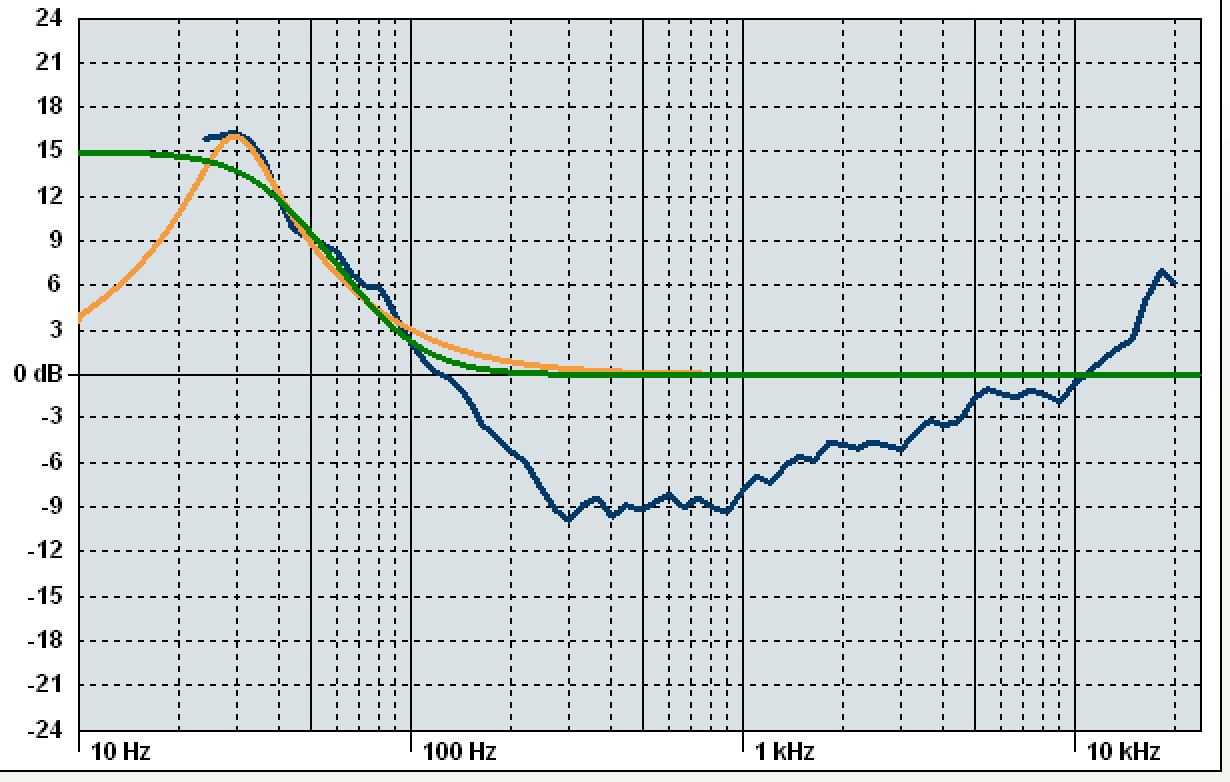
Indeed 😀 Passive components only will just trade one potential issue for an actual one 🙂
So a sort of conclusion is, and was for me anyway, don´t use digital volumen control!
I have settled with a Light Speed type volumen control :
http://www.diyaudio.com/forums/anal...d-ldr-volume-source-selection-controller.html
This is IMHO the only analog volumen control that is totally transparent.
I have not been able to hear when it is in the chain or out...
So a sort of conclusion is, and was for me anyway, don´t use digital volumen control!
I have settled with a Light Speed type volumen control :
http://www.diyaudio.com/forums/anal...d-ldr-volume-source-selection-controller.html
This is IMHO the only analog volumen control that is totally transparent.
I have not been able to hear when it is in the chain or out...
Analogue volume control can help but you are right that not all analogue volume controls are well implemented.
That looks to be a nice volume control solution, the digital volume control in the sabre DAC I have works well within 40 dB or so. Jriver's works on a high bit rate too so it should be equally as good.
How do you evaluate a volume control being in or out of a circuit without using something else to also set the volume?
If by dangerous you mean subjective then I would agree in part because loss of resolution in a converter is a real issue particularly with digital volume control, but it is very likely that some people will hear the effect differently and therefore argue it's validity like so many other topics 😉
Changing the boost from digital to analogue shouldn't change the overall level going to the amp if the same target has been used, the point is to change the level in the converter to be more even throughout the frequency range.
Here is an example: Let's say you have a truly excellent 24bit DAC with a Signal to noise ratio of 127dB. At full volume the converter can realise just over 21 bits of resolution. The EQ average posted has a difference between the top boost and lowest cut of about 24dB that is 4 bits, so some parts of the spectrum can only be represented by 17 bits. That's OK because most music is 16 bit so you can get it all without any loss of resolution. But then you use digital volume control and for every 6dB you turn it down you lose another bit, say you listen at -18dB now you only have 14 bits on part of the spectrum. Listen at -30dB and now you are at 11 bits.
If you have a 24bit DAC with a SNR of 100dB (not uncommon) you only started with the ability to represent 16.6 bits before the noise floor.
The question remains can you hear a difference? Without being able to do an A/B test of the analogue boost it is hard to speculate.
I think it is worth trying to see if there is a benefit.
You can try of course, just build it up first and listen to these arrays as is. The way I want to try and see if there are differences is to add the subs (not to replace the arrays in the bottom end but to add them there) and create headroom that way.
Critical listening is always done at the same volume (I let JRiver handle the differences based on average levels between tracks) and the chain is optimised at that level. For movies I attenuate an extra 5 dB compared to music.
Meaning I set my system for a 15 dB average dynamic range for music and 20 dB for movies. Which means a track with less dynamic range than 15 dB gets attenuated by JRiver to average at the same level as a track with an actual 15 dB dynamic range. Does this mean I can't play a track with a dynamic range of 20 dB? No, because we attenuate the range from 100 dB up to 10 KHz it still plays fine unless it actually has high levels of bass. (I did not encounter such tracks, except with movies. Which is why movies get played at -5 dB compared to music)
Playing back at -30 dB won't be critical listening anymore. I'll accept the degradation if I can actually hear it above my room's noise floor.
In all honesty, the graph I posted of the EQ is a bit older, I make use of room gain from my left array at 30 Hz (I swap SPL level there between left and right array) and that way I "only" boost about 12-13 dB max currently. Some music tracks needed that headroom.
I fully expect I can win some headroom with the added subs, though at full tilt with movies (at that -5 dB extra attenuation) the current level is crazy as is with low content blasts in movies. My room definitely protests. 😛
I should add there are two ways for me to play louder;
1- pick a track with less than 15 dB dynamic headroom and set JRiver to play up to peak levels.
2- walk over to my amp and adjust it's dials 😉.
I actually set it up like this to protect me and my family. When playing the arrays there wasn't an easy way to determine how loud it was playing. Unless you tried to have a conversation. I figured I'd be better off to protect us from playing too loud.
There sure are differences in imaging at different SPL levels, it's like a zoom button.
Playing everything at the same average level works out best for me. It's also easier to determine how tweaks differ from session to session as the overall SPL level will be the same.
1- pick a track with less than 15 dB dynamic headroom and set JRiver to play up to peak levels.
2- walk over to my amp and adjust it's dials 😉.
I actually set it up like this to protect me and my family. When playing the arrays there wasn't an easy way to determine how loud it was playing. Unless you tried to have a conversation. I figured I'd be better off to protect us from playing too loud.
There sure are differences in imaging at different SPL levels, it's like a zoom button.
Playing everything at the same average level works out best for me. It's also easier to determine how tweaks differ from session to session as the overall SPL level will be the same.
I don't have any intention of trying an analogue EQ addition until I have measured the arrays I have built to see where and how much boost is needed. It also isn't that difficult for me to try in a simple way to see if it is worth pursuing any further. It may be that even a 6dB shelving filter is enough to tip the balance back.You can try of course, just build it up first and listen to these arrays as is. The way I want to try and see if there are differences is to add the subs (not to replace the arrays in the bottom end but to add them there) and create headroom that way.
Sounds like a good idea.Critical listening is always done at the same volume (I let JRiver handle the differences based on average levels between tracks) and the chain is optimised at that level. For movies I attenuate an extra 5 dB compared to music.
I don't understand this part 😕Meaning I set my system for a 15 dB average dynamic range for music and 20 dB for movies. Which means a track with less dynamic range than 15 dB gets attenuated by JRiver to average at the same level as a track with an actual 15 dB dynamic range. Does this mean I can't play a track with a dynamic range of 20 dB? No, because we attenuate the range from 100 dB up to 10 KHz it still plays fine unless it actually has high levels of bass. (I did not encounter such tracks, except with movies. Which is why movies get played at -5 dB compared to music)
The level of attenuation you use to reach your preferred listening level will be very dependant on the total system being used. -30dB on my Najda when listening to the LX521 at 1V output is a comfortable level. I usually listen between -26 to -15, the volume control is analogue though so it doesn't impact on signal to noise when turned down.Playing back at -30 dB won't be critical listening anymore. I'll accept the degradation if I can actually hear it above my room's noise floor.
In all honesty, the graph I posted of the EQ is a bit older, I make use of room gain from my left array at 30 Hz (I swap SPL level there between left and right array) and that way I "only" boost about 12-13 dB max currently. Some music tracks needed that headroom.
I fully expect I can win some headroom with the added subs, though at full tilt with movies (at that -5 dB extra attenuation) the current level is crazy as is with low content blasts in movies. My room definitely protests. 😛
I only posted the thought as something to consider based on my experience with another system that had significant levels of boost and didn't work as well with a DSP crossover as it did with the analogue.
The example was meant to show the mechanism at play and is not a criticism. You have shown that incremental improvements can have a significant effect on the overall outcome. This is just another thing to think about including to see if it adds up. There is at least good theory to suggest it should work.
That makes more sense, analogue volume control on the integrated amp.2- walk over to my amp and adjust it's dials 😉.
So you have set Jriver to maximum output without clipping from the EQ and ultimate volume is set by the pot on your amp?
The Najda has virtually no headroom above 0dB so the input needs to be reduced to accomodate the boost applied or it clips regardless of output level. Jriver is using 64 bit internals so it likely has huge headroom to apply the boost and just attenuate it at the end to avoid the clipping.
Yes. Viewed this way I use analog volume control while maximizing the gain on the DAC without clipping. I chose an arbitrary max volume level and attenuate from there using JRiver's internal volume control. However the amp needs to have volume adjustment for that to work.
Quite different from having an amp without a volume knob behind the DAC with volume control right there on that DAC.
That's still part of the puzzle for me with an increasing amount of channels used.
Whenever I move to an amp without volume control this part gets much more critical. I guess my strategy really needs analog volume control or some means of gain adjustment.
Quite different from having an amp without a volume knob behind the DAC with volume control right there on that DAC.
That's still part of the puzzle for me with an increasing amount of channels used.
Whenever I move to an amp without volume control this part gets much more critical. I guess my strategy really needs analog volume control or some means of gain adjustment.
Last edited:
Yes. Viewed this way I use analog volume control while maximizing the gain on the DAC without clipping. I chose an arbitrary max volume level and attenuate from there using JRiver's internal volume control. However the amp needs to have volume adjustment for that to work.
Quite different from having an amp without a volume knob behind the DAC with volume control right there on that DAC.
That's still part of the puzzle for me with an increasing amount of channels used.
Whenever I move to an amp without volume control this part gets much more critical. I guess my strategy really needs analog volume control or some means of gain adjustment.
You could do a simple test on your system to find the point of digital volume control where you can notice the degradation.
Turn your amp up so you have to turn Jriver down. Measure with your spl meter so you know how many db's you turn the amp by to knock it down in Jriver to the same level.
The Jriver volume control is a good one so in theory it should be useful to -40dB give or take the hit from processing boost.
Multichannel analogue volume control is not an easy thing to get at a reasonable price. The CS3318 chip used in the Najda is good but I don't know of a kit or cheap product that uses it.
I found a kit on Taobao that could go up to 8 channel using a New Japan volume control IC, a switched resistor type with pretty low distortion. The same sort of thing that is used in an AV receiver. It had remote control and a display too was only about 30 to 40 AUD.
You could do a simple test on your system to find the point of digital volume control where you can notice the degradation.
Turn your amp up so you have to turn Jriver down. Measure with your spl meter so you know how many db's you turn the amp by to knock it down in Jriver to the same level.
The Jriver volume control is a good one so in theory it should be useful to -40dB give or take the hit from processing boost.
Multichannel analogue volume control is not an easy thing to get at a reasonable price. The CS3318 chip used in the Najda is good but I don't know of a kit or cheap product that uses it.
I found a kit on Taobao that could go up to 8 channel using a New Japan volume control IC, a switched resistor type with pretty low distortion. The same sort of thing that is used in an AV receiver. It had remote control and a display too was only about 30 to 40 AUD.
With the volume control koldby showed and the one you bring up I think I could just do what I do now and be save. Choose a max SPL level, adjust the gain there (making use of the analog volume control) and let JRiver handle everything below that max SPL level. So if I add an amp, I just need to make sure to add a (good quality) volume dial somewhere (doesn't need to be visible).
This would be the easiest way for me. I can use every mobile devise as a remote etc. The PC already is the player for music and Home Theatre. In time I might add a turn table for old time sake. I still have my complete vinyl collection stored in the attic.
Can't wait for measurements!
Thanks me too!
I found the link to the volume control if anyone is interested
https://world.taobao.com/item/522747175729.htm?spm=a312a.7700714.0.0.yrPXyi#detail
I got delayed thinking about analogue filters but I managed to pull myself back to making the towers, now I have two with the fabric finished.
Attachments
those cabs are gorgeous! It would be a sin to pull a stocking over it...Thanks me too!
I found the link to the volume control if anyone is interested
https://world.taobao.com/item/522747175729.htm?spm=a312a.7700714.0.0.yrPXyi#detail
I got delayed thinking about analogue filters but I managed to pull myself back to making the towers, now I have two with the fabric finished.
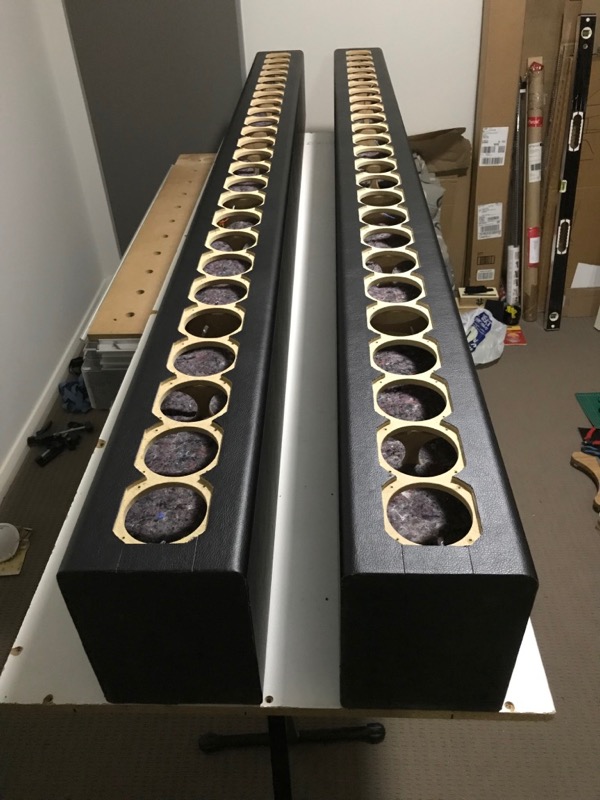

those cabs are gorgeous! It would be a sin to pull a stocking over it...
I agree, they are quite attractive as is 🙂.
I'm glad you guys like it, I've seen the tower up close with the sock and I really like the look. Things often look different in person to pictures, I like the neatness and 'perfection' to the surface with the sock in place. Everything is smoothed out and all the little lumps and bumps are hidden.
- Home
- Loudspeakers
- Full Range
- Full Range TC9 Line Array CNC Cabinet
